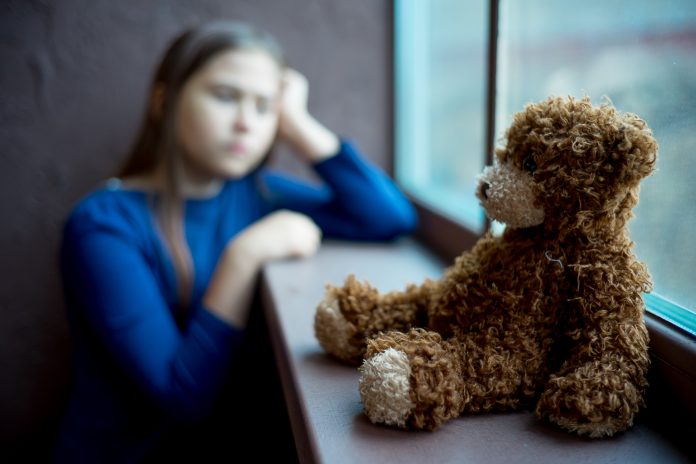Whilst autism spectrum disorder has neurological evidence, it is often misdiagnosed in children with Trauma – what happens then?
Of course many diagnoses given to children are accurate. Moreover, for some conditions, such as autism spectrum disorder, there is indisputable neurological evidence. That being said, what follows is a concern with misdiagnosis, which, in so many cases is utterly preventable if we are trauma informed.
Parents and teachers can find themselves bewildered as to why a child is behaving in a way that seems so different to that of other children. Some are relieved when the child is then given a diagnosis. For others, in some cases, they feel really uncomfortable, as the diagnosis doesn’t feel quite right, and they have a sense that something else is going on.
Often they are right, and what’s going on involves underlying causes of painful life experiences, particularly trauma and loss that is fuelling challenging or disturbing behaviour and awkward ways of relating to other people.
These painful life experiences can result in symptomology very similar to some of the most common child diagnoses.
The worry is that after a child is diagnosed, people stop thinking and the painful events in the child’s life that may be triggering his or her behaviour and ways of relating to people, remains unheard. In contrast, in trauma-informed schools, communities and child professional practices, there are two questions, not one – “Why he is behaving like this?” but also, “What has happened to him?” In many cases where there has been a misdiagnosis, the latter explains the former.
When the bad things that have happened in a child’s life are heard, the attention deficit hyperactivity disorder (ADHD)-type or autism spectrum-type behaviour makes perfect sense. This is because the child’s behavior and ways of relating are entirely understandable as coping mechanisms and defences resulting from traumatic experiences, when the child had no one there at the time to help them make sense of a painful event.
In fact both child professionals and the children themselves often fail to see the connection between the traumatic life events they have suffered (e.g. parental divorce, witnessing domestic violence, living with a parent with drug addiction) and the symptoms they have.
But the trauma is alive in the symptoms and until the child is helped to process what happened to them with an emotionally available adult, those symptoms will prevail. When we don’t hold in mind the child’s life story, such symptoms can all too easily result in adults misdiagnosing with labels ADHD OR ASD.
In fact the child’s unheard life narrative flies in the face of health and safety. In other words, it is tantamount to neglect to not help the child make sense of what has happened to them. This is because the meaning the child puts on those painful life events usually involves negative self – referencing. “Daddy beat me every day because I was being badly behaved. I deserved it”.
So in effect the trauma continues, played out every day in their minds, their behaviour and their symptoms. And so all too often we don’t help them with that, instead we label them. An abject failure of vital enquiry.

We can’t just have physical health and safety – both our bodies and our minds must be protected. Mental health should be incorporated in our protective policies, otherwise we are failing to protect children from the consequences of misdiagnosis, and treatment that isn’t going to work.
If we are not trauma informed, ensuring before giving any diagnosis and medication that we have heard the child’s life story to rule out trauma, we are in danger of damaging that child psychologically, and possibly neurologically, when giving them medication for a condition they don’t actually have.
there are two questions, not one – “Why he is behaving like this?” but also, “What has happened to him?”
By way of example, putting a child who does not have ADHD on medication is a serious breach of health and safety. Common side effects of ADHD medication (methylphenidate and other psychostimulants) on young brains include stunted growth, sleeping and eating problems and decreased bone density, which can lead to osteoporosis later in life (Annual Meeting of the American Academy of Orthopaedic Surgeons, 2016).
Any pharmacological intervention can only ever be a blunt instrument compared to the ‘subtle symphony’ of brain chemicals released through positive human interactions. For example, attachment play has been found to be as effective as low doses of methylphenidate, without any risk of damaging brains (Panksepp et al 2003).
How often does misdiagnosis happen?
Some people might hope that misdiagnosis is a rare occurrence. I’m afraid not. The adverse childhood experience (ACE) study carried out on 17,000 people in the United States, found that if you have experienced several ACEs, you have a high chance of being diagnosed with ADHD, conduct disorder or being on the autism spectrum (Anda et al 2005).
Take Mary age 8, for example. She has suffered many painful life experiences including being beaten as punishment, living with a mother addicted to alcohol and her father who suffered from anxiety and depression. Mary also witnessed domestic violence. She had an ACE score of six.
As the number of ACEs increases, so does the likelihood of a child or teenager being given a psychiatric diagnosis. In one study, 100 children were told they had ADHD by school staff. Only three were correctly diagnosed (none of the three had ACEs), the rest had experienced multiple traumas (acestoohigh.com/2014/Burke Harris 2017).
Symptomatology of ADHD and several other common child diagnoses is very similar to that to childhood trauma and loss: agitation, difficulty concentrating and hyperactivity. Research shows that traumatised children often have the same over-activation in a key detecting threat system in their brain (the amygdala) as soldiers coming back from war-torn countries (McCrory et al 2011). This can result in them being hyperactive, on guard and unable to settle to learn. Some of these children are then permanently excluded from schools as a result of their psychological distress presenting itself through their behaviour (Ford et al 2018).
It is a gross failure of empathy to exclude traumatised children because of their difficult behavior, without ever asking what has happened to them. And we know when we do ask what has happened, find a high ACE score, and then provide an emotionally available adult to help them to grieve, work through and make sense of what happened, symptoms are alleviated. The evidence is overwhelming; there is a huge body of research discussing what is called ‘social buffering’ or ‘protective factors’ (Gunnar 2017).
Example of ADHD diagnosis and the tragedy of the ‘unheard narrative’
Ben, 8, was doing well at school and had loving relationships with his parents. Then one day his parents separated. Ben’s behaviour deteriorated. He became very aggressive towards his mother. His schoolwork went downhill and teachers complained that his concentration was very poor and that he often got out of his seat in an agitated fashion.
Ben was taken to the doctor, diagnosed with ADHD and prescribed Ritalin on his first visit (75% of children evaluated for conditions such as ADHD and oppositional defiant disorder receive medication on the very first visit to the doctor). It didn’t work, so his mum took him to behaviour modification sessions. They also didn’t work. The relationship between Ben and his mother deteriorated, until eventually she called in social services and he was taken into residential care.
In part, this is a tragedy of an unheard narrative.
At no stage did anyone ask Ben what is was like for him when his parents split up. In addition, no one had done any neuroscience homework. If they had, they would have found the research that shows that children who are not securely attached, without help can move from traumatic loss to aggression (Chester et al 2013).
This is part of a neurochemical reaction to grief, which triggers high levels of the chemical acetylcholine coupled with opioid withdrawal, resulting in aggression. When a child is helped to mourn, and is soothed and comforted, acetylcholine levels returns to base rate and opioids (anti-aggression neurochemicals) are once again activated. The child then no longer has anger problems.
This is part of a neurochemical reaction to grief, which triggers high levels of the chemical acetylcholine coupled with opioid withdrawal, resulting in aggression.
Too often help like this is not available. One only has to watch many instances of children moving from loss to violence in the Educating Cardiff, Essex, Yorkshire etc TV series, to see time and time again how a child suffering from a major loss becomes hugely disruptive. It then takes a mass of staff resources to manage their challenging behavior, while the narrative remains unheard.
In other words, no one sits down and asks the child directly what they are feeling about the loss and helps them to grieve and work through it.
Other children diagnosed with ADHD just need more time to grow up. Research shows that younger children with less developed frontal lobes are more likely to be labelled with ADHD: “If a child is behaving poorly, if he’s inattentive, if he can’t sit still, it may simply be because he’s five and the other kids are six. There’s a big difference between a five-year-old and a six-year-old, and teachers and medical practitioners need to take that into account when evaluating whether children have ADHD” (Elder 2010).
Example of a child with an autism spectrum diagnosis (ASD) and the prevention of misdiagnosis because the child’s narrative was heard
Research that looked at 47,000 areas of the brain comparing autistic and non-autistic brain showed reduced cortical functional connectivity in areas to do with theory of mind (interest in other people and the ability to imagine what someone else might be thinking or feeling), emotion and social processing, and sense of self in the autism spectrum (Cheng W et al 2015).
Seb, 11, was a foster child who experienced seven different placements after he was moved from his birth parents following a history of abuse. Seb was diagnosed as on the autism spectrum for the following reasons.
Just like many children on the autism spectrum, Seb had a need for order, for sameness and repeated routines. He would show extreme anxiety with any changes. He had such a difficult journey to school, and was often heard recounting to himself each step of his journey, “I am going to walk to x, then cross the road, then get the bus”. This over-attention to detail and high level of anxiety is a common characteristic of ASD. Yet, it is also a common trait in children with traumatic pasts.
With such chaotic home lives, their anxiety around change and need for order is understandable. Seb also found the social world very difficult; he had poor eye contact, a bland expression and never smiled. He showed no interest in what other people thought or felt.
But finding the social world difficult and wanting to avoid it is also a common trait for traumatised children. Seb was not able to show empathy, which again is an ASD trait, but it is also a trait of developmental trauma, not because of a neurological issue (as is the case in ASD) but because the pain caused Seb to distance himself from his own feelings and those of others.
Seb was not able to show empathy, which again is an ASD trait, but it is also a trait of developmental trauma
However, Seb began working therapeutically with a psychologist (Martha) who was interested in and listened to his life narrative. She questioned his diagnosis of ASD after finding he lied very well, which is uncommon for children on the autism spectrum due to poor theory of mind. Secondly, using drawing and metaphors, he could symbolise his painful life experiences well.
Children with a correct ASD diagnosis can find images and metaphors difficult and tend to live in a more literal world. Seb was also insightful about what was fuelling his parent’s cruelty, and over time become interested in Martha too and asked her questions about her life. He also showed good communication skills. So Martha knew he had no problem with theory of mind or social and emotional processing. Seb worked through his painful life experiences, grieved his traumatic childhood experiences and went on to do very well.
Many children don’t have the opportunity to tell their story, often because people show no curiosity and don’t see how vital it is to know. Consequently, these children are left with an unheard narrative.
Let’s change that and demand trauma-informed inquiry before any diagnosis is given.
Dr Margot Sunderland
Child Psychologist, Psychotherapist, Neuroscience Expert
Director of Education and Training
The Centre for Child Mental Health and Co-Director of Trauma Informed Schools UK
For further information on stress, child mental health and training please call 020 7354 2913 or visit: https://www.childmentalhealthcentre.org.
References
Anda, Robert F. et al. (2006) The Enduring Effects of Abuse and Related Adverse Experiences in Childhood: A Convergence of Evidence from Neurobiology and Epidemiology. European archives of psychiatry and clinical neuroscience 256(3): pp. 174 – 186.
Bolaños, Carlos A et al. (2003) Methylphenidate treatment during pre- and periadolescence alters behavioral responses to emotional stimuli at adulthood Biological Psychiatry, 54(12), pp. 1317 – 1329
Brown, David W. et al. (2009) Adverse Childhood Experiences and the Risk of Premature Mortality. American Journal of Preventive Medicine, 37(5), pp. 389 – 396
Burke Harris, N. How early childhood experiences affect children’s future Available at: https://www.youtube.com/watch?v=OMbYUfiUsco (Accessed: 11 June 2018)
Cheng, W. et al. (2015) Autism: reduced connectivity between cortical areas involved in face expression, theory of mind, and the sense of self, Brain, 138(5), pp. 1382–1393
Cheng, W. et al. (2017) Functional connectivity decreases in autism in emotion, self, and face circuits identified by Knowledge-based Enrichment Analysis, NeuroImage, 146, pp.169-178
Chester, D. et al (2014) The interactive effect of social pain and executive functioning on aggression: an fMRI experiment. Social Cognitive and Affective Neuroscience, 9(5), pp. 699 – 704
Edwards, V. J., Dube, S. R., Felitti, V. J., & Anda, R. F. (2007). It’s OK to ask about past abuse. American Psychologist, 62(4), pp. 327 – 328.
Elder, T.E. (2010). The importance of relative standards in ADHD diagnoses: evidence based on exact birth dates. Journal of health economics, 29(5), pp. 641 – 56.
Ford, T. et al. (2018) The relationship between exclusion from school and mental health: A secondary analysis of the British Child and Adolescent Mental Health Surveys 2004 and 2007. Psychological Medicine, 48(4), pp. 629-641
Fuller-Thomson, E. and Lewis D. (2015) The relationship between early adversities and attention-deficit/hyperactivity disorder, Child Abuse & Neglect, 47, pp. 94-101.
Moll, G. et al. (2001) Early methylphenidate administration to young rats causes a persistent reduction in the density of striatal dopamine receptors Journal of Child and Adolescent Psychopharmacology, 11(1), pp. 15-24
McCrory, Eamon J. et al. (2011) Heightened neural reactivity to threat in child victims of family violence Current Biology, 21(23), pp. 947-948
McCrory, Eamon, Stephane A. De Brito, and Essi Viding. (2011) The Impact of Childhood Maltreatment: A Review of Neurobiological and Genetic Factors. Frontiers in Psychiatry 2, 48 doi:10.3389/fpsyt.2011.00048
Musser, Erica D. et al. (2016) Attention-Deficit/Hyperactivity Disorder Developmental Trajectories Related to Parental Expressed Emotion Journal of abnormal psychology, 125(2), pp. 182–195
Nocjar, Christine & Panksepp, Jaak. (2002). Chronic intermittent amphetamine pretreatment enhances future appetitive behavior for drug- and natural-reward: interaction with environmental variables. Behavioural brain research, 128, pp. 189-203
Panksepp J. et al. (2003) Modeling ADHD-type arousal with unilateral frontal cortex damage in rats and beneficial effects of play therapy, Brain and Cognition, 52(1), pp. 97-105
American Academy of Orthopaedic Surgeons (2016) Annual Meeting of the American Academy of Orthopaedic Surgeons











